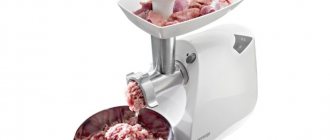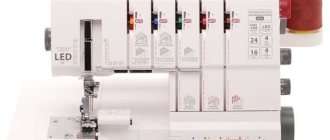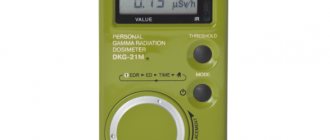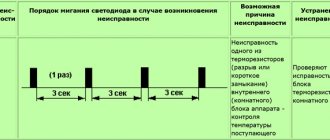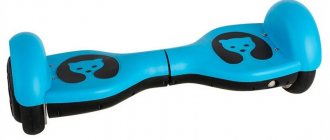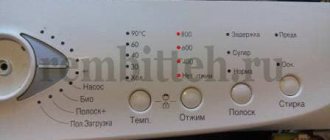Purpose and types of meat grinders
The meat grinder is designed for grinding food. The main function is the production of minced meat, poultry and fish . The device also successfully processes any vegetables, both raw and cooked. If necessary, you can also crush, for example, nuts. The functionality of the device is expanded using different devices (attachments).
Meat grinders are divided into two main types:
- mechanical;
- electric.
There are also so-called combine devices that operate on the principle of a blender. But the final product after this process can hardly be called minced meat. Most of all, the processed mass resembles puree. Therefore, such a device cannot be called a full replacement for a classic meat grinder.
Electrical appliances have their own class.
- The highest class “A” is awarded to industrial units for high productivity. The MIM 300, 82 and 105 brand line is widely used. It should be noted that industrial models require power from a three-phase network for their operation. They are capable of processing from 200 to 300 kilograms of meat per hour. But the weight of such a meat grinder is not small - on average about 50 kg.
- Class “B” has devices that perform many functions thanks to an additional arsenal of attachments, knives and grids. They are represented by the brands Moulinex, Bosch, Kenwood. Among domestic models, consumers highlight the KEM-36 electric meat grinders.
- “C” class meat grinders are household devices of minimal power and without additional modes. Such budget models are widely produced by Zelmer, Braun and Saturn.
Principle of operation
The principle of operation of a manual meat grinder comes down to feeding the product, which is pre-divided into portioned pieces of the required size, into the receiver located on top of the device. A special screw, called an Archimedean screw (according to one of the branches of physics), moves these pieces towards the knives. The shaft rotates using manual torsion.
Next, a four-blade knife cuts the product and directs it to the grid, the holes of which have sharp edges and also serve as choppers. When passing through the knife mesh, the raw material is brought to the desired consistency and, in the form of finished minced meat, comes out of the nozzle to the outside, where it is collected in the receiving tray.
The operation of an electric meat grinder is fundamentally no different from the above-described principle of operation of a mechanical analogue. Only manual torsion replaces an electric motor powered by a household voltage of 220 volts. But the electric version has a number of undeniable advantages relative to manual models:
- the power of even the weakest budget device is several times greater than muscular strength;
- the processing speed of any product is much higher than with manual torsion;
- grinding fibers with veins does not cause difficulties (whereas a mechanical machine needs to be disassembled and the knives cleaned every time);
- no additional fasteners are required: the device works perfectly on any flat surface;
- the extended receiver protects against injury: fingers cannot reach the auger, and there is a special device (pusher) for pushing pieces of raw material.
Meat grinder MIM-82: device, principle of operation, t/b.
Meat grinder MIM-82
consists of a base, a housing, a chamber for processing products, a loading device, working parts, a drive mechanism, and control buttons. In the body of the meat grinder there is a working chamber for processing products, made in the form of a cylinder, on the upper surface of which there is a screw thread, which improves the flow of meat and prevents its rotation along with the auger.
Rice. 4.1. Meat grinder MIM-82:
a - section: 1 - electric motor; 2 - processing chamber;
3 — screw finger; 4 - pressure nut; 5 - auger;
6 — safety ring; 7 — pusher;
8 — screw shank; 9 — loading bowl;
10 — cylindrical helical gear; b - general view: 11 - base; 12 — body; 13 – louvered grilles
The working parts of the meat grinder are an auger, 3 grids with holes with diameters of 3, 5 and 9 mm, 2 double-sided knives and a scoring grid.
In the assembled meat grinder, the knives and grates are pressed tightly against each other using rings and a pressure nut.
In the working chamber, a screw rotates, having the shape of a single-thread screw with a variable pitch of turns. The auger grabs the meat and feeds it to the knives and grates. The helical line of the screw to increase the force of pushing the product is made with a decreasing pitch.
Double-sided knives are installed with their cutting edges facing the direction of rotation of the auger, i.e. counterclock-wise. When installing two grilles, the grille with the larger holes is placed first.
The drive mechanism of the meat grinder consists of an electric motor and two cylindrical helical gears.
Operating principle: The prepared meat is placed in the loading bowl and pushed through with a pusher. Once in the chamber, the product is captured by a rotating auger and moved towards the knives and grates. The meat is pressed through the holes of the fixed grates and cut off with rotating knives.
Straight double-sided knives cut the product using the chopping method, while the scoring grid uses the cutting method, since the knives are located at an acute angle.
If the meat that has passed through the meat grinder turns out to be insufficiently chopped, it is passed through the machine a second time, installing grates with smaller holes.
1. Theoretical performance is the most important characteristic of any design. It is on this basis that kinematic and thermal calculations are performed, the speeds of movement of working bodies, parts, coolants and coolants are determined, power consumption, loads, working volumes, overall dimensions and many other equipment parameters are calculated. Therefore, during the line design process, it is important to analyze the relationship between the specified technical productivity and the designed, theoretical productivity.
2.The machine for slicing gastronomic products MRG-300A consists of a housing, an electric drive, a circular knife, a cut thickness regulator, a universal tray, a sharpening device and other components.
Machine for slicing gastronomic products MRG-300A: 1 - body; 2 — lever; 3 — base of the lever; 4 - regulator of cutting thickness of products;
5 - switch; 6 — receiving bath; 7 — support table; 8-disc knife; 9 — clamps for securing the tray; 10 - universal tray; 11 — movable support; 12 — tray clamps for oblique cutting of the product; 13 — protective casing of the circular knife
Machine for slicing gastronomic products MRG-300A: 1 - body; 2 — lever; 3 — base of the lever; 4 - regulator of cutting thickness of products;
5 - switch; 6 — receiving bath; 7 — support table; 8-disc knife; 9 — clamps for securing the tray; 10 - universal tray; 11 — movable support; 12 — tray clamps for oblique cutting of the product; 13 — protective casing of the circular knife
The electric drive of the machine is located inside the housing and consists of an electric motor, two worm gearboxes and a four-link articulated mechanism. The first worm gear drives the disc blade, the second drives the universal tray with the product through a four-link mechanism. The universal tray allows you to cut food at an angle from 30 to 90°. There is a support table under the loading tray. The product is in the tray and falls freely under its own weight in the direction of the knife and onto the support table. The cut slices pass between the knife and the support table and fall into the receiving tray. The thickness of the slices is regulated by the gap between the circular knife and the support table, on which there is an adjusting nut and a dial indicating the thickness of the cut. The disc blade and carriage are driven by an electric motor. All parts of the machine are fixed to the body, which is equipped with four rubber supports. The machine is equipped with a sharpening device consisting of two abrasive stones.
Machine productivity is 45 cuts per minute. The thickness of the slices is from 0.5 to 15 mm, the maximum cross-section of sliced products is 150x150 mm. The diameter of the disc blade is 300 mm, the rotation speed is 390 rpm, the electric motor power is 0.27 kW. Machine weight - 50 kg.
Before starting work, you need to inspect the machine, check the cleanliness of the surfaces, grounding and sharpening of the knife blade. Sharpening is checked with a strip of newsprint, holding the edge to the blade of the stationary knife. When sharpened well, the paper is cut through by a knife, but when sharpened insufficiently, it tears. In this case, you need to sharpen the knife according to the instructions.
The product prepared for slicing is placed on a tray and fixed with a movable support, while the product, under the influence of its own weight, must rest freely on the surface of the support table. Then install the receiving tray. By turning the dial, the cutting thickness is set for rennet cheese - 1.5-3 mm, for smoked sausage - 1-2, for boiled sausage - 3-5 mm, etc. The circular knife begins to rotate, and the lever with the tray moves back and forth. forward movement. When the tray moves towards the knife, part of the product enclosed between the plane of the support table and the cutting edge of the knife is cut off and the slice falls into the receiving tray. When the tray moves back, the remaining product, under the influence of its own weight, slides off the tray in the direction of the support table to a distance of the thickness of the slice being cut. When cutting the same name
It is recommended not to wait for the complete cutting of one piece of product, but to insert a new one, which will press the previous one, thereby achieving proper cutting of the remainder. When moving on to cutting another product, the knife is thoroughly cleaned with a spatula to avoid salting the slices of the new product.
Upon completion of work, it is necessary to turn off the machine, disconnect it from the power supply and sanitize it. To do this, you need to remove the tray, protective shield, knife and wash them with hot water and detergent, rinse and wipe dry with a soft cloth. Use a brush to remove crumbs from under the knife. Wipe external surfaces with a clean cloth.
Trade organizations widely use Italian-made slicers for slicing products.
Basic device
Many housewives prefer a manual machine because of its ease of use. The structure of a manual meat grinder is not much different from an electric one. Next, the working parts that make up the apparatus will be listed and their purpose will be described.
- Frame. It can be made of cast iron, aluminum, stainless steel and even plastic with a mandatory hole that plays the role of a receiving compartment for processed raw materials (located, as a rule, on top).
- Screw shaft. Its function is to move the product to the knives.
- Circular or cross-shaped knives. These parts are used to grind the product.
- Grinding grid. It also functions as a knife. The meat grinder comes with a set of such meshes with different hole diameters, which allows you to grind minced meat of different fractions.
- Clamping nut for knife. It prevents the cutting parts from falling out during operation and ensures their tight fit to each other, which is a necessary condition for high-quality grinding.
- Pen. With its help the auger rotates. Its fastening to the shaft is ensured by a fastening wing.
- Latch. It is designed to securely secure the device to the table.
Important! The design of a meat grinder powered by electric current is completely identical to its mechanical counterpart, with the exception of one component: the handle is replaced by a motor that ensures the rotation of the Archimedean screw.
In addition to the main parts described above, the electric meat grinder circuit includes many additional parts necessary for the correct operation of the engine. So, in the electrical circuit there is:
- electric motor;
- a capacitor that provides initial acceleration of the rotor;
- "Start" button;
- emergency switch;
- input for power cord;
- fuse;
- power indicator.
The body of the electric meat grinder is large in size, as it includes a compartment for the motor and other components that ensure the operation of the latter, and also contains openings for the exhaust of hot air . Adhesion to the table surface of such equipment occurs with the help of rubber feet, which prevent slipping due to vibration during operation. The video will show the internal structure of the electric meat grinder, as well as all additional attachments:
Electric meat grinder
Electric meat grinders are currently gaining significant demand. This is primarily due to their large number of advantages in comparison with other types of these devices. This concerns significant power, an increased level of safety, and the absence of the need for rigid fixation on the table.
Device
In order to understand the principle of operation of an electric meat grinder, you need to understand its structure. This device consists of the following parts:
- metal or plastic body;
- lattice;
- knife for food processing;
- fixing disk;
- electric motor;
- pusher;
- minced meat receiver;
- tray;
- screw shaft
Reference! Additionally, the components of electric meat grinders can be a variety of knives, attachments or auxiliary devices.
Principle of operation
Well-cut food products should initially be placed in the meat receiver. Using a pusher, pieces of meat are pushed by a person into the sleeve, after which they fall onto the augers. They have ribs that make it possible to reduce the volume of the largest particles. After passing through this mechanism, the crushed pieces collide with the grid. Slowly pressing through the latter, they are cut using a sharp knife, smoothly sliding along the surface.
Operating rules
In order for the electric meat grinder to be in good functional condition for a long time, it is necessary to adhere to some rules, such as:
- Pieces of meat should not be sent for processing along with bones.
- All components of the device must be thoroughly washed and dried after use.
- You need to constantly monitor the sharpening of the cutting elements. This will reduce the rate of engine wear.
By following the above rules, you can achieve long-term and reliable use of an electric meat grinder in the kitchen.
Additional accessories
Various additional attachments are available for both types of meat grinders, designed to perform work not related to grinding conventional minced meat. Such devices are included when the device is delivered or can be purchased separately.
Juicer
To extract the juice, you can use the grill with the largest holes. But in this case, the final product will have pulp. And a special nozzle, in which an additional screw directs the raw material onto a fine grater, allows you to obtain liquid without the admixture of solid particles. At the same time, losses of raw materials are minimal.
Shredders
Using a set of various shredders, you can quickly cut food for any salad. The device easily copes with the work of a food processor.
For sausages
The peculiarity of this attachment is that it specially distributes ground minced meat into sausage casings. With the help of the device you can make not only sausage, but also sausages and sausages.
For the test
A device for working with dough is capable of forming original cookies from the dough. There is also an attachment that will help you make homemade pasta.
Advice! Additional accessories turn an ordinary meat grinder into a device that can facilitate the preparation of dishes of any complexity. Therefore, a set of attachments purchased separately will not be superfluous in the household.
How to choose a meat grinder? Don't read if you're hungry
Productivity depends on power, but not only on it: the structure of the loading chamber (diameter) and the screw plays a role. The productivity of a meat grinder is measured in kg of minced meat per minute or per hour (different manufacturers use different parameters, but more often per minute). The average is 1.2-1.5 kg per minute, but sometimes 2 or more. You need to understand that the manufacturer is talking about ideal meat - completely stripped of veins, soft and beautiful - the kind that you probably won’t use for cutlets. So divide by 1.5-2. Now pay attention - is it really so important for you to turn your 5 kg of meat in two minutes, and not in 4-5? Therefore, we look at power, but without fanaticism. In addition, some modern models are equipped with low-power AC motors that consume no more than 170-200 W. The auger rotates a little slower, the productivity is lower (0.8-1 kg per minute), but the noise level is significantly reduced, the motor does not overheat, and the meat grinder can work longer without interruption. So there is a paradox: in advertising, manufacturers rely on power (higher, and higher, and higher!), but a good model may well not break records for this indicator.
Operating speeds
There may be one or two, but it's always better if you have a choice.
Motor protection
The motors in most meat grinders are protected from overheating by simply opening the electrical circuit when a certain temperature is exceeded. There is also such a thing: often at the junction of the auger and the engine mechanism there is a cap or fuse sleeve. If it is plastic, then when overloaded it will burst, and the motor will be blocked, and then you need to replace the fuse (plastic ones are often included in the kit - this is convenient, please note: if they are not included, you will have to look for them in case of a problem).
Reverse function available
The reverse button activates the rotation of the auger in the opposite direction, which is convenient if a vein is wound around the knife or auger or something is simply stuck. It’s good if the reverse is short-term, that is, the auger will stop on its own. If there is no automatic stop, the device will need to be turned off. Well, get the stuck stuff out of the loading chamber. There is an opinion that powerful models do not need reverse and grind meat with veins and cartilage. This is not true - if the core is wound, it cannot be ground even at high power. But you can unwind it.
Knife
A good knife is double-sided and self-sharpening. You don’t need to think about which side to put it on, and if you make a mistake, curse, disassemble the meat grinder and take out pieces of “under-rolled” meat (because the mistake can only be detected in practice).
Grates and auger
Most often they are made of ordinary carbon steel, but there are models where these parts are made of stainless steel. Carbon steel is susceptible to corrosion, so you need to immediately wash these parts and dry them. In addition, meat grinders with such grates and auger are not suitable for preparing vitamin reserves of products - black currants, etc., because vitamin C is more destroyed when in contact with parts made of ordinary steel. If the grates and auger are made of stainless steel, then you can put them off for a long time - for example, in the dishwasher.
There are most often two or three gratings - with different hole diameters. Here you need to look at this very diameter: a large one is not often found, and many people like to feel the meat.
Operating rules
To increase work efficiency, the raw materials should be cut in advance into pieces that can easily pass through the receiver of the machine to the auger . In order for the shaft to capture the product, you need to use a special pusher to feed the pieces onto the knives.
Important! Preliminary removal of large veins from meat will facilitate the operation of the engine in an electric meat grinder, and will keep the knives from quickly becoming dull.
In order for the meat grinder to work for many years, you need to follow the operating rules and take care of the device after completion of work.
- To avoid knife breakage when preparing meat for processing, you must carefully remove all bones from it.
- Before work, it is recommended to install a special grinding wheel instead of a grate and sharpen the knife. This will speed up and make grinding the product easier.
- Like car engine parts, the insides of the meat grinder need to be lubricated with oil (in our case, vegetable oil). Processing the shaft, knife and grate will improve product passage and increase productivity.
- After use, the device must be immediately disassembled and washed.
- After drying, it is better to store the unit disassembled in a box. This way the parts will be less subject to oxidation.
A meat grinder is an indispensable attribute when preparing many dishes. And the use of special attachments makes the device multifunctional, which only increases its value as a universal kitchen assistant.

